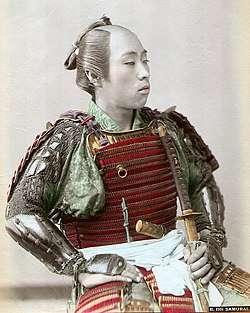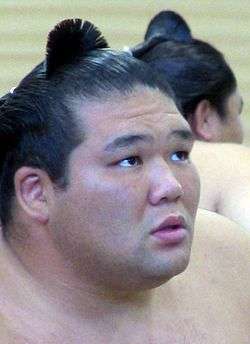Chonmage
The chonmage (Japanese: 丁髷) is a form of Japanese traditional topknot haircut worn by men. It is most commonly associated with the Edo period and samurai, and in recent times with sumo wrestlers. It was originally a method of using hair to hold a samurai helmet steady atop the head in battle, and became a status symbol among Japanese society.


In a traditional Edo-era chonmage the top of the head is shaved. The remaining hair was oiled and waxed before being tied into a small tail folded onto the top of the head in the characteristic topknot.
History
In the Edo period of Tokugawa Shogunate Japan, orders were passed for Japanese men to shave the top, front of their head (the chonmage hairstyle) and shave their beards, facial hair and side whiskers.[1] This was similar to the Qing dynasty queue order imposed by Dorgon making men shave the pates on the front of their heads.[2]
Sumo
In modern times, the only remaining wearers of the chonmage are kabuki actors and sumo wrestlers. The sumo style of the chonmage is slightly different, in that the pate is no longer shaved. However, the hair may be thinned in this region or the crown of the head shaved, called nakazori, to allow the topknot to sit more neatly.
Sumo wrestlers with sekitori status are required on certain occasions to wear their hair in a more elaborate form of topknot called an ōichō or ginkgo leaf style, where the end of the topknot is splayed out to form a semicircle, resembling a hand fan (sensu). Given the uniqueness of the style in modern Japan, the Sumo Association employs specialist hairdressers called tokoyama to cut and prepare sumo wrestlers' hair.
The chonmage is of such symbolic importance in sumo that snipping it off is the centerpiece of a wrestler's retirement ceremony. Dignitaries and other important people in a wrestler's life are invited to take one snip, with the final one taken by his trainer.
In modern fashion

Outside Japan, so-called "samurai buns" have been worn by a minority of young British, Australian, Canadian, European, and American men during the mid-2010s.[3] Unlike the traditional chonmage, the hair on top of the head is kept long, and the back and sides are shaven[4] This hairstyle, reminiscent of the samurai topknots in jidaigeki movies, was popularised by celebrities including Orlando Bloom, Jared Leto, Zayn Malik, TOWIE's Joey Essex, Harry Styles, and Brent Burns.[5] Although this haircut is somewhat similar to the Japanese topknot, it is visually more closely related to the topknots worn by historic Western tribes, such as the Lombards, Vikings, and Cumans. The medieval historian Paul the Deacon, in his description of the traditional style of the Lombard nation, describes their hair thus so, "they uncovered the flesh of their heads by shaving all around the neck, sides, and back of the head until the nuchal zone. The hair on the top, left long, was parted in the middle and hung down to the corners of their mouths." (HL IV.22).
See also
| Wikimedia Commons has media related to Chonmage. |
References
- Toby, Ron P. (2019). Engaging the Other: 'Japan' and Its Alter-Egos, 1550-1850. Brill's Japanese Studies Library. BRILL. p. 217. ISBN 978-9004393516.
- Toby, Ron P. (2019). Engaging the Other: 'Japan' and Its Alter-Egos, 1550-1850. Brill's Japanese Studies Library. BRILL. p. 214. ISBN 978-9004393516.
- "The Samurai Hairstyle – Or How Men With Curly Hair Use Buns! – The Lifestyle Blog for Modern Men & their Hair by Curly Rogelio". The Lifestyle Blog for Modern Men & their Hair by Curly Rogelio. 2013-04-11. Retrieved 24 September 2015.
- Nikita Mukherjee. "Mens Hairstyle In Focus: The Man Bun". www.mensxp.com. Retrieved 24 September 2015.
- "Brent Burns has turned a larger-than-life NHL star". Retrieved 2017-04-09.
External links
- Choi, Na-Young (2006). "Symbolism of Hairstyles in Korea and Japan". Asian Folklore Studies. 65 (1): 69–86. JSTOR 30030374.
- Mageo, Jeannette (September 1999). "Hair: Its Power and Meaning in Asian Cultures:Hair: Its Power and Meaning in Asian Cultures". American Anthropologist. 101 (3): 676–677. doi:10.1525/aa.1999.101.3.676. S2CID 161624655.
- Jo, Ki-Yeu; Jung, Yeon (2001). "일본 남성의 헤어스타일 변천에 관한 연구 - 고대에서 근대까지 -" [Study on the Changes of Men's Hair Styles of Japan - from Ancient to Modern -]. Fashion & Textile Research Journal (in Korean). 3 (4): 337–343.
- Ito, Sei (1961). "Lovable Topknot". Japan Quarterly. 8: 473.
- O'Brien, Suzanne G. (10 November 2008). "Splitting Hairs: History and the Politics of Daily Life in Nineteenth-Century Japan". The Journal of Asian Studies. 67 (4): 1309. doi:10.1017/S0021911808001794.
- Zhuo, Li (2015). "The Metamorphoses of the Pigtail Image in Modern Japanese and Chinese". Nankai Journal. 1: 8.
- Pflugfelder, Gregory M. (3 December 2012). "The Nation-State, the Age/Gender System, and the Reconstitution of Erotic Desire in Nineteenth-Century Japan". The Journal of Asian Studies. 71 (4): 963–974. doi:10.1017/S0021911812001222.
- Stillfried, R. "Hairdressing". Metadata database of Japanese old photographs in Bakumatsu-Meiji Period.

